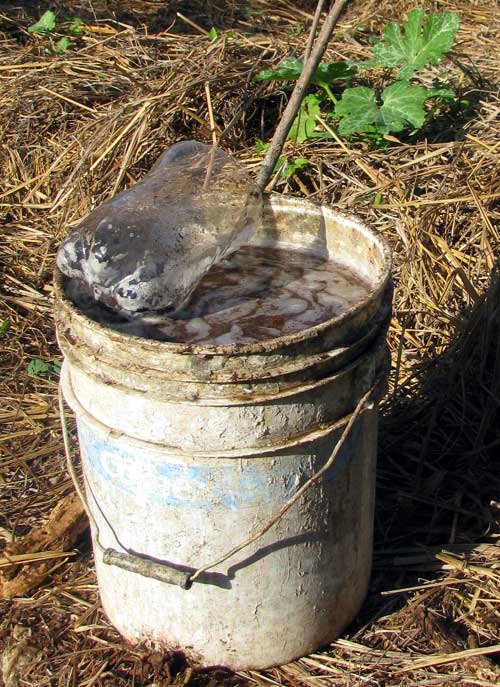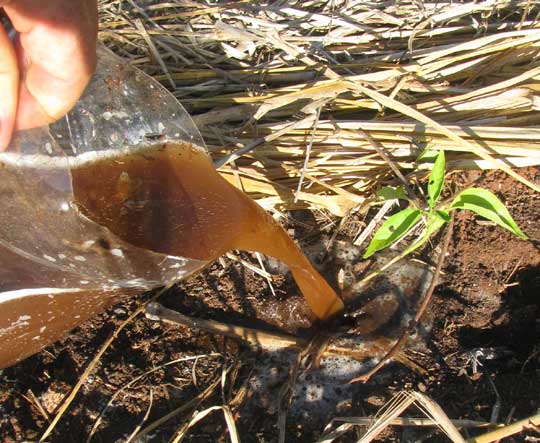Excerpts from Jim Conrad's
Naturalist Newsletter
from the June 13, 2010 Newsletter issued from Hacienda Chichen Resort beside Chichén Itzá ruins, central Yucatán, MÉXICO
HORSE MANURE TEA
The organic garden got off to a rough start because we had no manure, compost material or other good source of organic nutrients, plus we had none of the usual insect-battling basic tools such as diatomaceous earth and BT (Bacillus thurengiensis). The seedlings I started from seeds, as expected, turned out spindly, yellowish and disease-ridden.
But then one afternoon this week my friend José drove up to the hut with seven big bags of dried, dusty horse manure, and that marks the beginning of our getting serious about having an organic garden. The first thing I did was to fill a bucket with manure, overtop that with water, and let it all sit overnight. The next morning I had manure tea. You can see what a bucket of manure tea looks like in my garden below:

Tea being poured onto an anemic pepper plant is shown below:

One day after dosing each plant in the garden with tea already the plants were a little greener than the day before, and experience tells me that within a week the garden will look much different from its current sorry state.
Serious organic gardeners already know about manure tea, and there's a world of different recipes for it. Most recipes I've seen advise using either cooked manure or manure composted at temperatures high enough to kill disease organisms. Also, most recipes call for putting the manure into a bag, then soaking the bag for two or three days as nutrients seep from the manure into surrounding water. After two or three days the bag is removed, leaving behind pure tea. Hort-Pro On-line Magazine's special Manure Tea page is at http://www.rittenhouse.ca/hortmag/Bruce/ManureTea.asp.
I just let my loose manure soak overnight, using no bag. What results is a watery slurry that when poured around the plant leaves atop the soil something like wet coffee-grounds. I've happy for that organic matter to accumulate there, knowing that during later waterings and rains, more soluble nutrients will be leached from it and made available to the plant's roots below.
My tea is surely full of microorganisms that should never find their way into a salad. However, I'm not growing lettuce and the like. All plants producing potential salad ingredients are staked or trellised so that their edible parts remain well above water- splashing level. And I wash my hands real well each time I come in from working in the garden.
Here few horses are kept in stalls with floors covered with hay to absorb the horse's nitrogen-rich urine. Most Maya horse manure falls onto a limestone-derived, rocky mineral soil. When manure dries, it loses much or even most of its usable nitrogen. Sill, I expect that José's horse manure will provide the garden with a good nitrogen jolt.
Some people avoid using horse manure in gardens because horses don't chew their food as well as cows and most other livestock, so their manure contains a relatively high amount of weed seeds that can germinate in a garden. Our garden plants so desperately need nitrogen, phosphorus, potassium and the rest, though, that I'm not too worried about weed seeds.
A page discussing various angles of using manure in gardens, and comparing manures from different animals, is at http://www.ecochem.com/t_manure_fert.html.
On that page maybe the most important insight passed along is that "The principal value of manure is its extended availability of nitrogen." In other words, you put it on your garden, then for a long time it keeps releasing nitrogen.